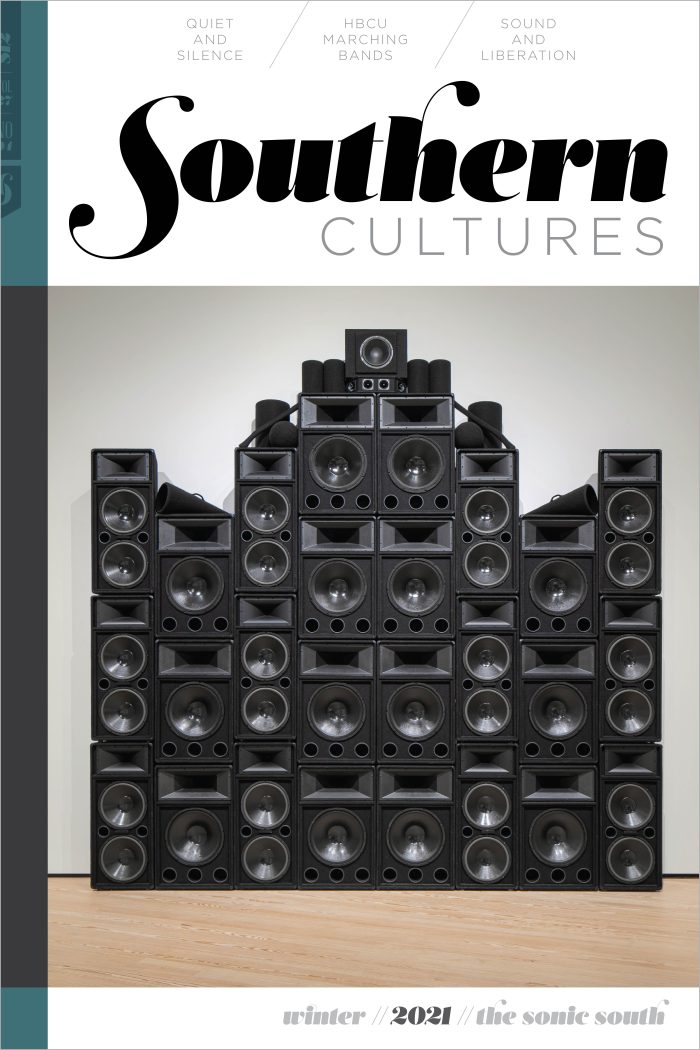I.
I grew up between Minneapolis and a small farm just outside the city on the occupied Indigenous homelands of the Dakota people in the Twin Cities and also of the Anishinaabe, or Ojibwe people, to the north. As an adult who has moved away from and returned to Minneapolis multiple times over the past twenty years, I often visit the banks of the Mississippi River. Specifically, a place on the west bank that is just downriver from the Lake Street Bridge.
Upriver from this photo is the sacred Dakota area of Owámniomni (turbulent waters), St. Anthony Falls in English. Just downriver is Mnigaga, Minnehaha Falls. And just a little bit further downriver is Bdote. Bdote is a Dakota word that generally means “where two waters come together.” The word can refer to any place where waters converge, but the Bdote that I am referring to has deep significance for the Dakota people; it is the meeting place where the Mnisota Wakpa (Minnesota River) and the Ȟaȟáwakpa (river of the waterfalls) or Wakpá Tháŋka (great river), both known as the Mississippi River, come together. It is essential to Dakota spirituality, past and present. It is considered the center of the earth. As a Mdewakantonwan elder has taught me, this Bdote is both the center and everywhere. It is both spatially located and dispersed. And the Twin Cities of Minneapolis and St. Paul are built on everything that is important.1
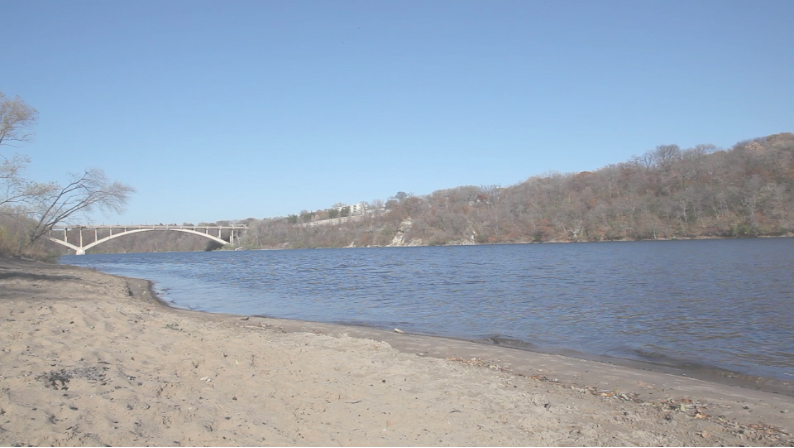
Sound, too, is located and dispersed. This is an essential aspect of sound that brings me and binds me to it as a means of learning and for artwork. Listen around you. What do you hear right now? As I write this, I can hear the hum of traffic from my apartment. I can hear the dull roar of an airplane. This sound is coming from somewhere very specific, but I can’t see that place. It is far from me, but I can hear.
For me, sound is a powerful practical and conceptual tool. Locating sound enables one to be specific and detailed, make room for variations, and disrupt generalizations. And the expansive and dispersed nature of sound often offers opportunities to connect that specific sound to the broader system of which it is a part.
In the bathtub, I put my head underwater to wet my hair. I am still. I can hear my heartbeat, the blood pounding in my ears. I can also hear sounds in the walls of my apartment complex—the metal pipes clicking, the mechanics of the building. These sounds I am hearing are located within my own body and are the broader architectural workings of the building.
Sound waves can move through the medium of water faster than through air. This means I can hear the faraway almost immediately, as if it’s right next to me. The clinking metal pipes sound like they are right in the bathtub with me, for example. This technical reality of sound offers me the chance to collapse distance and time and expand them back out again. It offers the chance to connect a present sound to its history.
II
My mother’s family is from Plaquemines Parish, Louisiana, on the east bank of the Mississippi River, thirty miles downriver from New Orleans. Plaquemines Parish consists of two narrow strips of land that guide the Mississippi into the Gulf. From those narrow strips of land, vast wetlands extend and stretch away from the river.

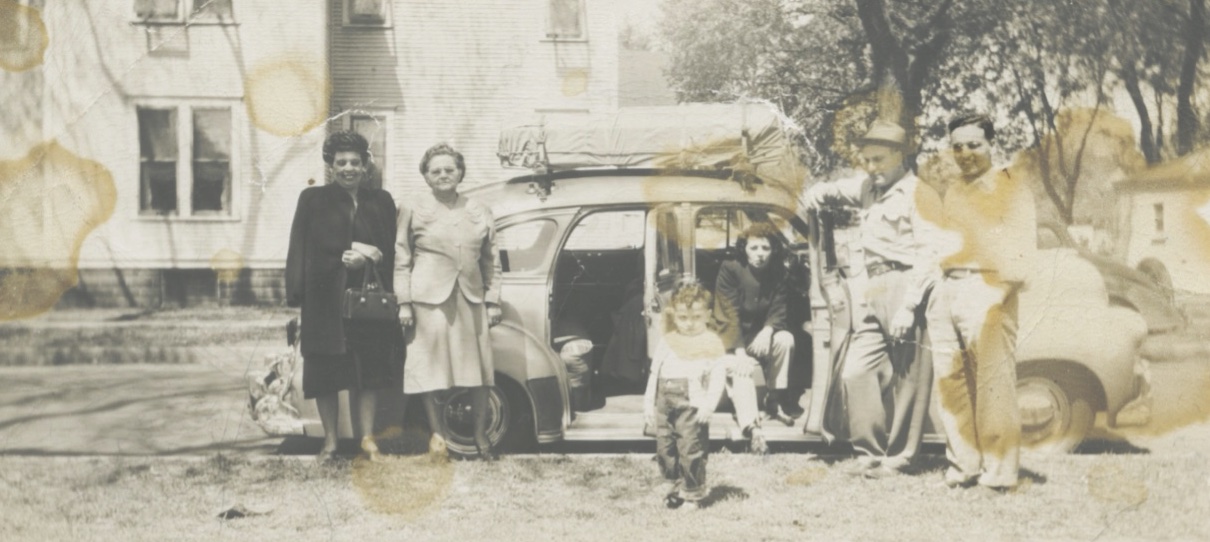
Imagine yourself there. You are on the east bank of the Mississippi, perched high in the branches of a dead oak tree near to the river. Directly across the Mississippi, on the west bank, is Phillips Oil Refinery, one of the highest-grossing refineries in the nation. Looking behind you, away from the river, are vast wetlands and eventually the open sea. Below you are skeletons of live oak trees, killed by saltwater intrusion and suffocation from hurricane surges, which uproot wetland grasses and redeposit them further inland, where, displaced and dying, they suffocate the trees’ root systems.
All around you are markers of environmental devastation and the agricultural, shipping, oil, and oyster industries that have enormous political sway. Across this vast landscape, salt water sweeps into what was recently marshland. This part of southern Louisiana is losing land at one of the fastest rates on the planet.
In the early 1900s, during the Great Migration, my great-grandparents migrated from coastal Louisiana to Minneapolis after their general store had been burned down multiple times. My great-grandfather was from Beirut, Lebanon, and my great-grandmother was Louisiana Creole, as she identified herself, a Black woman who grew up in Plaquemines. They moved north, but in the summers my grandfather returned downriver with his mother and siblings to help on the farm. Later, he brought his own family. And so my mother grew up making those trips and, eventually, so did I. This marshland where my great-grandmother grew up is still in my family. For three generations we have moved up and down this river, heading to and from this wetland on the east bank of the river.
This generational movement has informed my experience and spatial understanding of the Mississippi River. Going upriver. Traveling downriver. There is always a pull. There is always a place to go, there is always a person or an emotional energy to meet. When I stand by the river, whether on the west bank in Minneapolis or the east bank in Plaquemines, I feel this pull. This water is always moving, too.
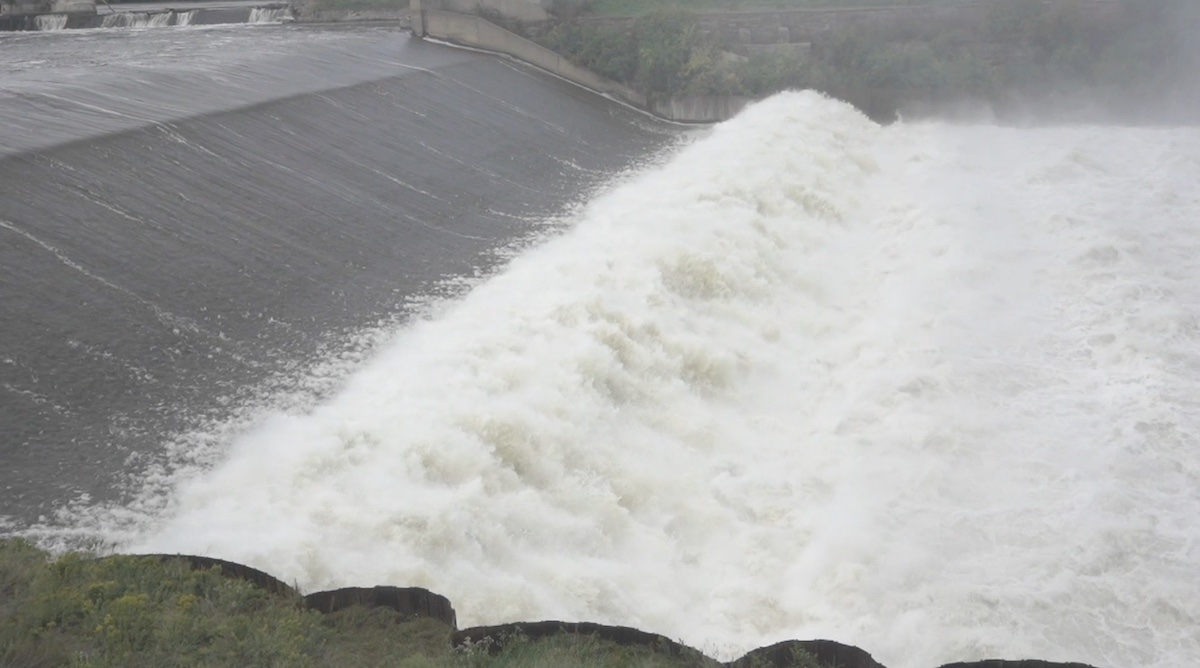
This linear movement between north and south is only one understanding within many, many ways of knowing this fluid watershed and river, called the Mississippi by Anishinaabemowin (Ojibwe) speakers, which translates to “giant river,” and Misha sipokni by the Choctaws, which translates to “beyond age.” Sound offers multiple vantage points, and sonic documentation offers me the chance to collapse distance and time and expand them back out again. This helps to show scale. The movement of generations. Sacred places and realities that are present but have been erased through colonial mapping and remapping. Here, sound is a medium to enter historic, political, environmental, and personal realities. Whatever present moment the river might invite me to, it is a thick moment, a moment in motion.
With the northern snowmelt in the spring in Minneapolis I get text messages from Albertine, our next-door neighbor in Plaquemines: “Girl, what are you sending us? Are we going to top the levees this year?” She sure hopes so. That would set the river where it wants to be, flooding the levees, replenishing the marsh with fresh water and river sediment. The river is always coming from somewhere; it is always going somewhere, bringing with it what it carries. In the spring it’s often swift with snowmelt, agricultural runoff, chemical pollutants, sediment, debris. Material. And the sound I’m hearing is the movement of water from before and after, the past and the future.
One recording was made on the upper Mississippi at Owámniomni. These waterfalls edged upstream, several inches per month, over many centuries, as the force of the falling waters gradually wore away the glacial debris and soft sandstone. This gradual progression proved inconvenient for industrial capitalism. In the 1870s, the Army Corps of Engineers fixed the falls in place to make it usable for flour milling, lumber transportation, and shipping. They first stopped the upstream progression of the falls by building a wooden apron and underground dike (a long wall or embankment), then rebuilt it in concrete in the 1950s and 1960s to further enforce its immobility. “Fixing” the falls, of course, did not stop the flow of the river. The rushing sound of the falls is the movement of water from the past to the future. It’s also the sound of energy changing form: labor, grain, capital, voltage, the churn of tourism fueled by its vistas.2
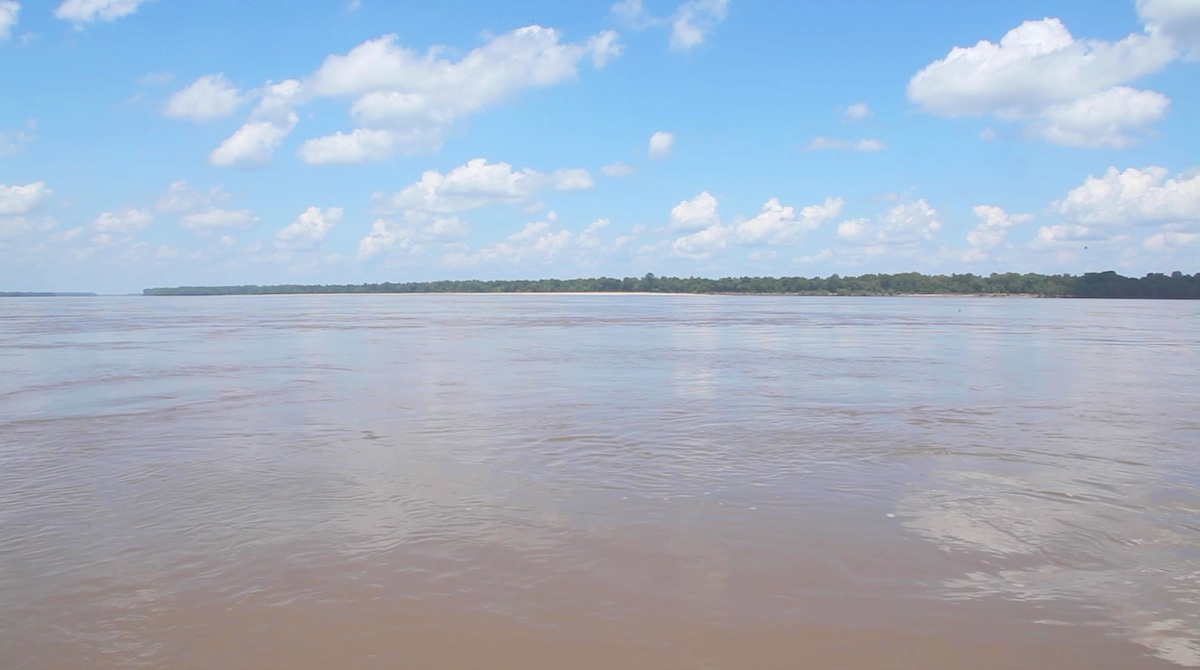
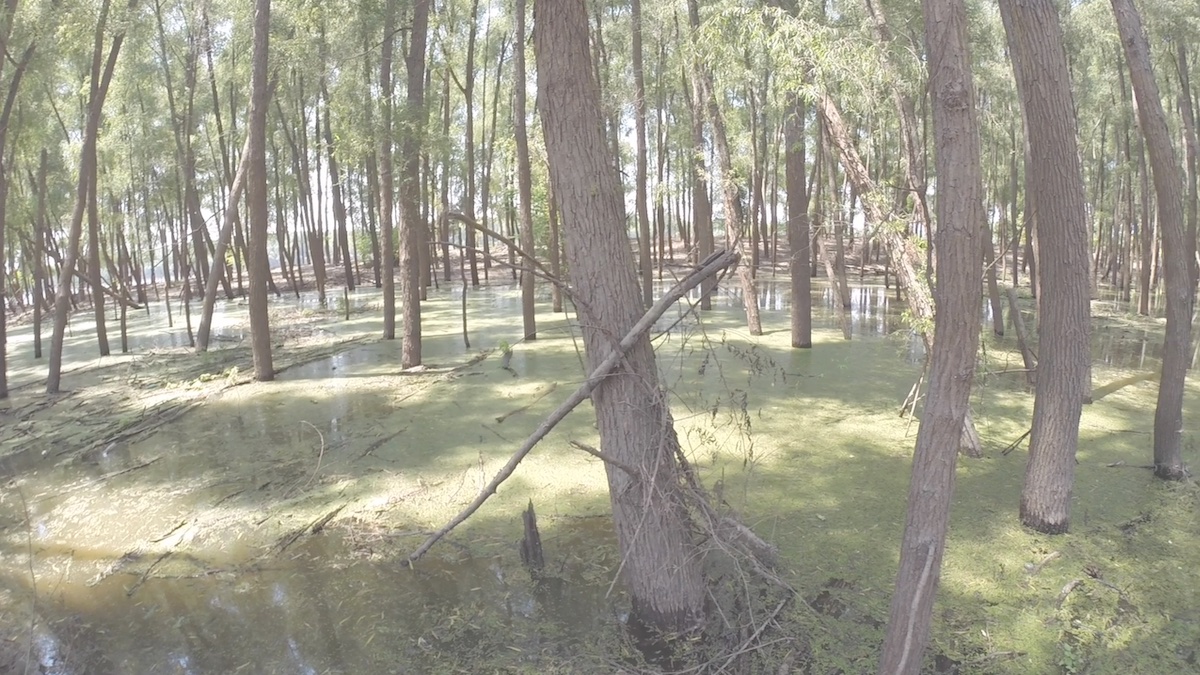
III
With sound, I try to create conditions to perceive what one cannot see and hear but already and always exists in a place. Part of the listening needed here is imaginative listening, or speculative listening.
Just south of Clarksdale, Mississippi, the locks and dams are long gone, the river is wild and immense. The river batture—the area of land between river and levee—is a willow forest over a mile wide, leaving space for a river that rises and falls eighty feet in any given year. In a recording of the alligator gar (audio clip 2 online), one can hear a deep, low croaking. An alligator gar is a large fish in the lower Mississippi whose fossil record dates back more than one hundred million years.
In this same recording from Choctaw Bar Island, can you also hear the low rumble and vibrating sound? This intense rumble is the relentless vibration of the microphone cord straining against the current. The vibration of the cable would generally be understood as sound interference, a technical problem intruding on the recording of the alligator gar. But technical sound “problems” are not problems. They are opportunities to disrupt the expectation of what one “should” hear or listen to in this southern soundscape. These aural interruptions are signifiers; they provide ways to enter deeper into the sound, the place, the present, the past, and one’s own imagination.
Here, the relentless vibration of the microphone cord straining against the current signifies to me the immense power of the river. At the time of this recording, in August 2015, the river’s recent high-water mark was fifty feet above my head on the uppermost branches of the willow trees. Here, sights and sounds signify the river’s natural capacity and need to expand and, in human terms, to flood. These sounds of the water’s power also foreshadow the ongoing systemic coercion of river and people. By this, I mean that throughout colonial expansion water’s power (and that of the unbuilt environment in general) has been viewed as something to tame, harness, and control. Along with it, groups of people have been captured and coerced to control that water through their forced labor. In 1927, for example, just twenty river miles downstream, in Greenville, Mississippi, hundreds of Black residents were forced by white residents into the deadly labor of reinforcing levees that had failed under high river conditions. A place where, as Tia-Simone Gardner writes, “the Black body was, is, undifferentiated from land and water that are habitually used to make life, for some, more livable.”3
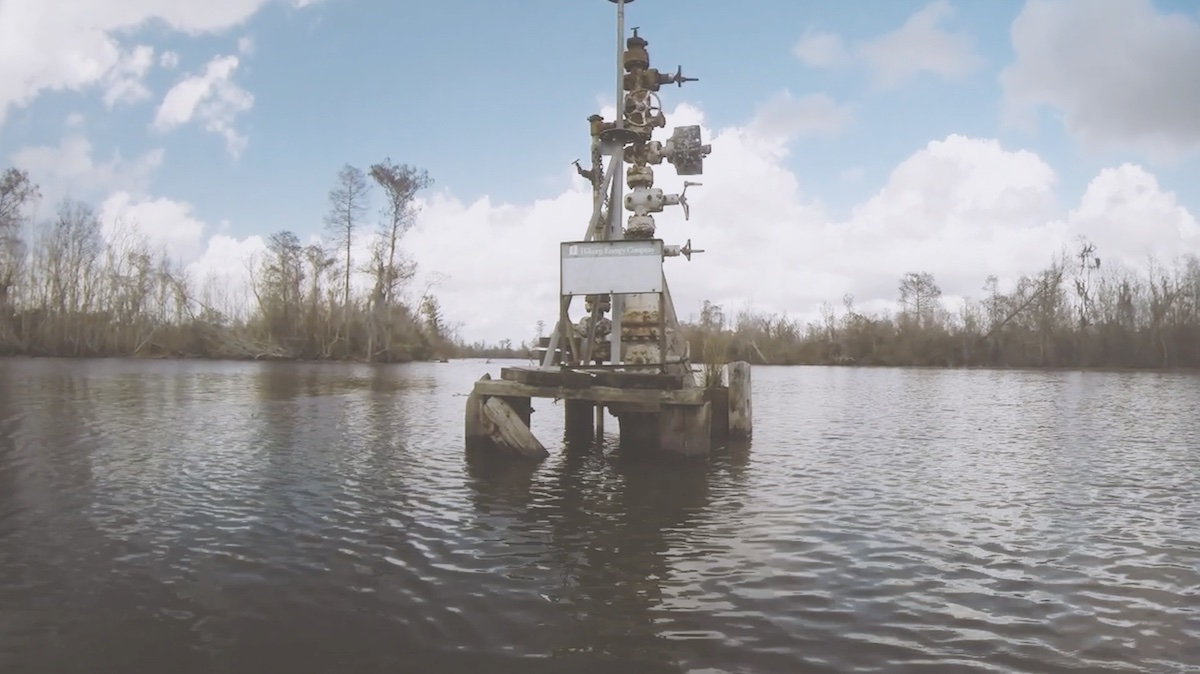
Silence registers, too. The sounds of oil slowly leaking from one of many uncapped wells in Louisiana bayous cannot technically be heard by the human ear; fluid displacing a fluid doesn’t cause breaks or ruptures that would create an audible splash or sound wave. And, again, this technical reality of sonic documentation is not a problem. Silence is crucial.
What does it mean here to give time and silence to something you cannot hear? What can come out of that silence? What can you do within that time?

IV
From my cousins’ house in the Upper Ninth Ward, I drove the short distance down to the Industrial Canal on the tenth anniversary of Katrina, a day of complex layers for many New Orleanians long weary of the disaster tourism in the city. For some, the significance of the day was strong. For others, each day since Katrina has its own work and this day was like any other. I put the hydrophone in the water. The microphone picked up interference from radio stations: a woman singing, the news reporting the Dow Jones Industrial Average. I also heard motors, lapping water, the static of a tugboat going by on the main channel, the horn of a nearby freight train. These were all sounds from one recording in the canal, one specific place where the ill-maintained levee broke and inundated the Lower Ninth Ward. What you can’t hear in this underwater recording is the nearby second line parade-protest for racial justice and climate justice that was happening simultaneously above ground, the sharp and concise criticism of violent, racist systems that prioritize industry and profit over environment and humans. Out of the static mix of this recording, I imagine, I remember, and I hear melancholy singing, engines, petrochemical industrial processes, the stock market news, voices and instruments from the protest, grief, and possibility.
This essay was first published in the Sonic South Issue (vol. 27, no. 4).
Monica Moses Haller is an artist whose work spans media, including photography, video, writing, sound, and installation. The underwater sounds included in her piece are part of a larger archive of artwork and actions called “Listening to the Mississippi.” This iterative project has unfolded since 2013 with many collaborators. Learn more.
- Tribal Historic Preservation Officer of the Mdewakantonwan people (one of the subtribes of Santee Dakota whose homelands are in Central Minnesota), in discussion with the author, Minneapolis, 2014. This deeply spiritual place (Bdote/St. Paul), also became the complex site of Fort Snelling, a concentration camp that held Dakota people forcibly removed from their homeland. Fort Snelling is also where Dred Scott and Harriet Robinson Scott were illegally enslaved, which they later challenged in a landmark Supreme Court case.
- Monica Moses Haller and Matt Rahaim, Listening to the Mississippi: Notes for Listening, pamphlet, Mississippi: An Anthropocene River (Berlin: Haus der Kulturen der Welt, 2019).
- Tia-Simone Gardner, “There’s Something in the Water,” Open Rivers 13 (Spring 2019): https://editions.lib.umn.edu/openrivers/article/theres-something-in-the-water/.

